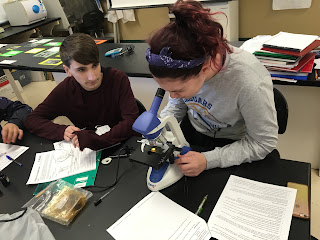LEAD success again!
LEAD Conference
This year our students that attended the (Leadership Experience and Development) LEAD conference went with a goal of putting fourth a large effort and emptying their "tanks". They worked very hard and were very self motivated. Three of our students were recognized as "Best Vice President" Maria Scarpantonio, Best Parliamentarian, Jayden Johnson, and Best Historian, Joseph Mild. Jenna Shallop and Harini Manjula Duraipandiyan worked very hard and each time I saw them were volunteering to answer questions and displaying leadership with our team as well as other attending chapters. NJ State FFA Staff and NJ FFA officers commented to me about how hard they worked and how special they all are. I am so proud and so blessed to have a devoted and dedicated group. Please join me in congratulating all of our LEAD attendees. You all made the event magical and rewarding! Feel free to post a comment to these students below.
Course Updates
Ag Research and Development
Students worked hard and put forth effort (sometimes emitting smoke from their ears) to choose a research topic. Students had two topics of 1) current and looming destructive pest for NJ: Spotted Laternfly and 2) Antibiotic resistance. After much discussion and leaning on our Somerset County Extension Agent, our students decided to move forward with research Antibiotic resistance.
Animal & Plant Biotechnology
Lab notebooks are a major part of this course especially the discipline to keep it up with class. Students have learned safety procedures and common math operations for lab use. We are now doing lessons on DNA replication and will be presenting projects of how DNA replication happens and how it is useful in biotechnology.
Plant Science
Students have just completed their soils units to understand soil properties, determine soil texture, structure, structure grade, permeability, and run tests to determine these characteristics. We also recently completed a soil chemistry unit where students develop an understanding of pH's control over nutrient availability, determining salt / nutrient content in soils, and how to remedy both physical and chemical problems soils may have.
Intro to Food, Agriculture, and Natural Resources (FANR)
Have just finished a unit for communication. In this unit we discussed the importance of verbal and visual communication, presentation skills in voice, presence, effect, and power of expression. Students also learned parliamentary procedures and developed a rubric of characteristics effective teams have. We have recently moved into learning science lab equipment and safety.
SAE projects
Parents, If you have not had a chance to visit the AET site yet, please take a look at the AET home page and get somewhat familiar. I would like you to post a comment in the comment window below on one thing you learned your student can benefit from, or post a question you have. Both are welcome and encouraged. My goal is to see growth in student AET log ins and, records, knowledge, and subsequent recognition. This will possible with help and encouragement from parents. It may be as easy as just asking a simple question such as "tell me about..."












































